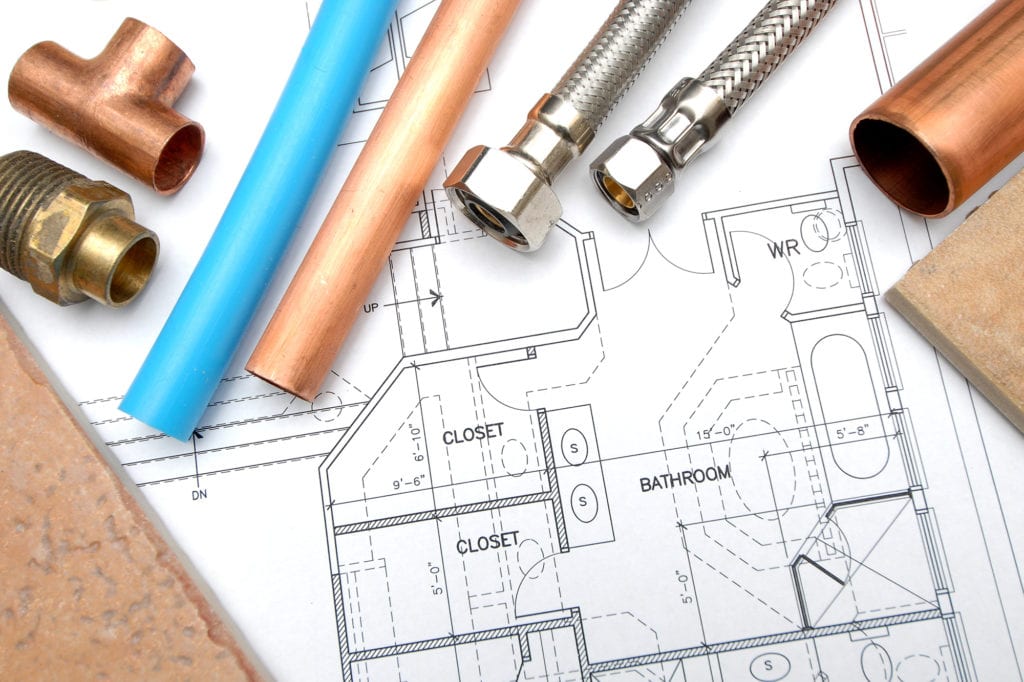Your home is packed with plumbing pipes. Most homeowners are aware that there are pipes in the walls, ceilings, crawl spaces of their homes, their basements, and even under the ground.
They understand these plumbing pipes serve different purposes. Some supply water or gas, while others are for drainage and sewer systems.
However, many homeowners cannot identify these pipes or know their specific purpose and qualities. Given that the installation and maintenance of these pipes can be a major expense, it is wise to know about the common plumbing pipes found in homes.
Let’s discuss these common plumbing pipes in homes and expand your knowledge on the subject so you know what you are dealing with when the time comes.
Hire the best, most experienced plumbers possible for any pipe installations and repairs because it is a long-term investment, and you only want professionals to handle it.
Common Plumbing Pipes in Homes
Below we will discuss some common plumbing pipes in homes, which you may find regularly.
We will also discuss one plumbing pipe, which you may no longer commonly see in homes anymore. However, it was the most common pipe of its time and was used for most plumbing purposes before better solutions were introduced.
PVC Pipes
Polyvinyl chloride, or PVC pipes, are white-colored pipes typically used for vent lines and drains in your home. When they were first introduced, PVC pipes became popular for being inexpensive, relatively easier to install, and very lightweight, especially when compared to heavy and rigid galvanized steel pipes or cast iron pipes.
Additionally, because of its polyvinyl nature, PVC pipes can be glued to each other using solvents, making it easy for longer runs, like for irrigation. Most homes in the US commonly use PVC pipes, and you may find them under your sinks or bathrooms, used as drain pipes.
Pros:
- Inexpensive
- Easy to cut
- Easy to install
Cons:
- Gluing is prone to leakage when applied incorrectly
- Gluing means pipes cannot be disconnected and must be cut
- PVC tends to degrade in direct sunlight
Copper Pipes
Copper is a long-lasting, dependable, lightweight metal that is 100 percent recyclable and does not contaminate water. Moreover, copper pipes are also fire and corrosion-resistant, which makes them an excellent option for water supply lines within your home.
The water supply does not get contaminated through copper pipes, and they can withstand high pressure. Copper pipes are easy to cut but require soldering to make connections. This task should only be handled by experienced professionals who follow safety protocols.
The one real drawback of copper pipes is that they are expensive due to the intrinsic value of copper. Therefore, even the waste copper pipes have a monetary value, and you can always get some returns from your copper pipes, even when they become useless.
Moreover, being 100 percent recyclable, they are great for the environment.
Pros:
- 100 Percent recyclable
- Durable and long-lasting
- Waste pipes have monetary value
- Can handle high pressure
- Does not contaminate water
- Fire and corrosion resistant
Cons:
- Expensive
- Soldering connections is not the easiest
PEX Pipes
Cross-linked polyethylene pipes, or PEX pipes, are the latest of the mentioned pipes and have quickly become a popular option across the world. These pipes are primarily used to supply water to homes, and they are not suitable for any other plumbing purpose.
The reason these pipes have become so popular for supplying water is that they are rigid enough to withstand the pressures of water supply yet flexible enough for home structures. These pipes are flexible enough to be weaved around ceilings, walls, and basements.
Before PEX pipes were introduced, plumbing for water supply pipes was not something professional plumbers or homeowners could do by themselves.
Pros:
- Inexpensive
- Flexible
- Easy to cut
- Easy to install
- Color-coded for cold (blue) or hot (red) water
Cons:
- Single-purpose pipe (water supply)
- Cannot be recycled
- Untested long-term use
ABS Pipes
Acrylonitrile butadiene styrene, or ABS pipes, are quite similar to PVC pipes. They were both introduced less than a decade apart, they are both categorized as plastic pipes, and they both serve a similar purpose in homes.
Similar to PVC pipes, ABS pipes are typically used for vent lines and drains in your home. If you were to compare a PVC pipe and an ABS pipe, you may think they are the same pipe, except that ABS pipes are black and softer than white PVC pipes.
ABS pipes are also relatively stronger than PVC pipes. Unlike PVC pipes, ABS pipes are prone to deform and warp at certain high temperatures. However, they are great for colder temperatures and even outdoor underground use.
Pros:
- Good for outdoor underground use
- Best for colder environments
- Stronger than PVC pipes
Cons:
- Deforms at certain high temperatures
- Is often not permitted by local building codes
Cast Iron Pipes
Still commonly found in many homes, cast iron pipes have traditionally been used for drainage and sewer systems in homes. Naturally, cast iron pipes are quite heavy and difficult to cut and install. They serve their purpose well; however, they rust completely through overtime.
Even though they are still common in homes, most professionals no longer recommend cast iron pipes and instead suggest ABS pipes to be retrofitted in older homes with cast iron piping.
Pros:
- None, except for use in drainage and sewer systems
Cons:
- Heavy
- Difficult to cut
- Difficult to install
- Rust completely through overtime
Galvanized Steel Pipes
Occasionally found in older homes, galvanized steel pipes were the dominant and common plumbing pipe choice for a very long time in history until better pipes were introduced. Traditionally, they were used for a wide range of plumbing and piping solutions, including:
- Water supply
- Gas supply
- Drainage system
- Underground piping
- Many more
Today, they are rarely used for anything except gas supply lines mainly due to their heavyweight, inflexibility, the difficulty of installation, and water contamination issues. They are no longer an option for water supply lines in any remodeling or new construction projects.
However, they are still required for gas supply lines, and you may also find them in older homes that haven’t been remodeled for many decades.
Pros:
- None, except for use in gas supply lines
Cons:
- Heavy
- Difficult to install
- Corrode overtime and clog supply
- Contaminates water and some pipes cause lead poisoning in the water supply
Conclusion
Plumbing pipes are a home necessity, and homeowners need to know the common types and their purposes. Hopefully, you now have a better understanding of the different plumbing pipes you see in your home.
The installation of plumbing pipes is best left to professionals. You also need to note that there are always rules and regulations. You must understand your local rules and codes before opting to install plumbing pipes of any kind.
Typically, plumbing pipes need support, and there is also some necessary testing required. While most of the mentioned plumbing pipes are commonly used in the US, some places still do not permit their installation and usage.
If you want to learn more about common plumbing pipes in homes, local permissions, or get the best plumbing services for your home in Jacksonville, Florida, please Contact Us today.

